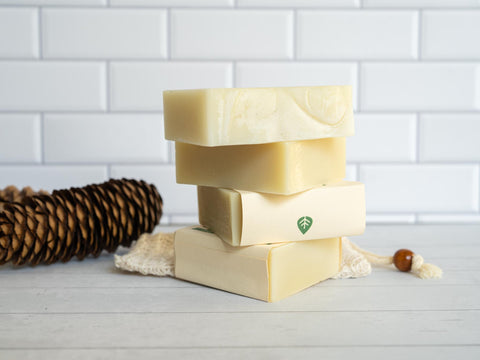How Natural Soap Bars Are Made

6 minutes to read

There’s nothing like the feeling of using the right soap that covers everything you need! Catering to your own needs is one of the greatest rewarding things about making your own soap at home.
If you’ve ever struggled with dry hands after washing the dishes from those store-bought dish soaps, trust me, we sure can relate! All the more reason to look into more natural soap bars that have the ingredients and scents you want.
From customizing your soap to saving money while helping our environment, making them can be an easy choice but tricky and tedious to do. But don’t be intimidated! We’ll touch on everything you’ll need to know before you select the right bar or make your own.
Summary
- What is a soap bar and how is it made?
- Rethink what you buy, it might not actually be soap
- If that’s the case, what should I look for in a soap bar?
- How we make our own soap
- Why does soap have to cure
- Why should I use a bar over those liquid dish soaps?
- Other things to consider when shopping for ingredients and soap bars
What is a soap bar and how is it made?
According to the literal and regulated definition, soap is a combination of fats or oils and an alkali called lye or sodium hydroxide. Lye on its own is known to be very corrosive and should be handled with caution. And while this may be present in the beginning, it is completely gone when your soap is properly made.
To do this, you’ll need to combine these ingredients in a hot or cold process that creates a chemical reaction called saponification and turns all that lye into soap. Thus, is safe and ready to use!
Melt and pour soups is another method that has been on rise, skipping many of these traditional steps and making it easier to do at home. However, you do lose out on customizing the oils that are into the soap and the process can be unforgiving with different ingredients and designs.
Rethink what you buy, it might not actually be soap
With the definition in mind, this actually rules out a ton of the “soaps” that you may see in the grocery store. A great example and one of the most recognizable is all those Dove bars! When you take a look at the packing, you’ll notice that they’ll call it a “beauty bar”.
That’s because they’re not actually made with all those needed ingredients for a soap bar and for legal reasons, they can’t call it soap. Instead, it’s considered a Syndet bar or a synthetic detergent.
If that’s the case, what should I look for in a soap bar?

According to studies and experts, here is a list of some of the most common ones you’ll want to look out for:
- Parabens
- Sodium Lauryl Sulphate (SLS)
- Synthetic Fragrances
- Phosphate
- Triclosan
- Palm Oil
While the majority of these are to be avoided for their irritation and overall impact on the body, palm oil is one of the many ingredients that have a huge negative impact on our planet. Their production has resulted in the loss of large tropical forests, affecting wildlife and plants.
Avoiding this in any product can help make sure we protect our much-needed forests and their ecosystems.
How we make our own soap

For our own soap making, we use ingredients that are plant-based and sustainable with our planet in mind. Having dishwashing soap bars instead of those liquid ones alone can cover and reduce the waste of 3-5 bottles of those liquid dish soaps!

These bars are handmade in Vancouver with only 4 simple ingredients; coconut oil, olive oil, water, and lye (eliminated in the saponification process). But don’t let these ingredients fool you, this bar is a powerhouse in the kitchen and cuts through stubborn grease with no problem.
And the best part? It is super gentle on the hands and has been an absolute life-changer for me. Making handwashing those dishes much more enjoyable, freeing them from toxins and reaping natural benefits from their ingredients.

This is all possible by the gentle and softness for the skin created by the olive oil, making it suitable for all skin types and conditions. While the coconut oil gives the bar that nice fluffy and stable lather that many other natural bars don’t have.
These bars overall are very concentrated, to make this bar last you for months on end while not being much different, if not better than typical soaps.
Why does soap have to cure?
Curing is a very important step that should not be missed as it gives the soap time for the saponification process to complete and let the water evaporate. It allows for the soap to harden and for the lye to be completely transformed. Because of this, don’t be surprised if your soap shrinks after it’s cured! This is something you should expect to happen and is a good sign that it’s cured.

The average amount of time to cure soap can take as much as a 4-6 week process. For us, we let our soaps cure for at least 2 months to go beyond this and guarantee that they are completely lye-free by the time they are used!
If you don’t let them properly cure before use, not only does it reduce the quality of the bar but also results in a soap that is much harsher on the skin and can still have lye remaining in the bar. This can cause skin or eye irritation and soap that is softer and does not last. More the reason why to let them cure for as long as they need or longer if possible.
Here’s an example of what happened to our soaps that didn’t cure as long as they should have:

In our first year of creating our dishwashing soap, we didn’t realize the benefits (and needs) of curing soaps. This meant that a few of those that received them were in bad shape by the time they arrived. Since then, we have revamped and improved our soap-making process with a standardized curing time.
Proceed with caution if you do make your own soap! The handling of hazardous materials like lye before its properly cured is what makes this activity difficult and has turned others to find handmade soaps makers instead.
Why should I use a bar over those liquid dish soaps?

As we’ve discussed, using a bar already gets rid of those bulky plastic bottles and dispensers in the kitchen. One other thing you’ll want to watch for is the excessive amount of water that is used in liquid soaps.
Not only are you paying for a watered-down soap, but you’re also paying for the cost of transporting that bottle since it takes up more space. Therefore, choosing the right bar over a liquid soap can make a huge difference for your wallet in the long run.
It may seem like it’s the easier one to use but it has even more cons than you’d think. Like commercial solid bars, liquid soap also has its own ingredients to avoid as we mention in our blog Why Should I Use Solid Dish Soap and not Liquid Soap?
Other things to consider when shopping for ingredients and bars
While not necessary, these 3 considerations can boost the value of your bars and make them last much longer:

Buy Bulk
To help reduce waste, buying bigger sized bars like a soap brick can also save you money and reduce the amount of waste and transportation needed. Keeping you stocked and worry-free about running out.
The same applies to any ingredients you buy! Look for a local refillery or a bulk store to get those ingredients at a lower cost and with less packaging.

Soap Dishes
In contrast to using those bottle dispensers, the best practice to make those bars last is to use a soap dish! These allow them to dry properly and depending on which one you use, can gather or deter that leftover water and residue from making a mess on your counters.
Support Small Local Businesses
Unlike bigger brands, supporting local businesses can not only reduce your impact further but help your community.
Making Soap At Home
With all that we’ve covered, there’s no wonder so many more people have been looking into their own bars to use! Especially when it comes to dishwashing, they are absolutely worth it with all the benefits they give you and how much cleaner they are with very little adjustment.
However, as we’ve shared in our own soap-making process, making your own takes a lot of time. Whether you decide to make your own or find one with all these features, the choice is up to you! But know that not only will your health thank you for using one, but so will our planet.
All things soap that we recommend to try!
- Tags: Solid Soap Bars
1 comment



I love this soap.the bamboo soap dish and.the brushes. Goodbye to plastic bottles and awful ( so called ) soap !!